
广东财经大学法学院 全英教学课程《国际经济法学》 课程教学大纲 一、课程基本信息 课程代码:20070024 课程名称:国际经济法(全英) 英文名称:International economic law(EL) 课程类别:专业课 时:64 学 分:4 适用对象:粤港澳大湾区法务班专业本科生 考核方式:考试 先修课程:法理学、民法、商法、经济法、国际公法、国际私法 球治理失灵 国际格局深刻变化,国家利益深 调整,新型治理疆域兴起 这些都呼唤着全球治理体系变革,而变革需要规范、秩序与法治。习近平总书记 强调,全球治理体系正处于调整变革的关键时期,我们要积极参与国际规则制定, 做全球治理变革进程的参与者、推动者、引领者。党的十八大以来,我国开创了 深化改革,推进“一带一路”建设和构建人类命运共同体的伟大实践。这些实践 的推进既对法学教育和法治实践提出了新要求,又是法 教有对国际法治如何守 世界贸易组织成立以来对世界经济发展尤其是中国经济的腾飞意义重大,中 国也由law-taker变成了law一maker。WT0法作为独特的多边国际法律制度,自 成立起对其规则,中国的涉诉争端案例,专家组报告,争端解决机制,上诉专家 组的改革等问题日趋受到广泛的关注。因此,以全英课教授国际经济法成为我国 入世后法学教育的重要任务,也为复合型、外向型、应用型涉外法治人才培养 实的法学专业知识。 二、课程简介 1.中文简介 战后建立布雷顿森林体系以来,我们己亲历国际关系趋向于独立和一体 化的巨大变革。国际经济法调整国家间的经济关系,涉及国际公法和国内法在私 人国际商贸领域的适用,具体涵盖国际经济中的货物、服务、知识产权授予与保 护、国际金融、外商直接投资和争端解决。这些法律的一致性和合规性问题常常 在国家和全球经济发展和福祉中存在。许多来自于WTO和ICSD这些国际组织 的国际贸易与投资规则虽已建立,但国际经济法律框架仍然无从定义并呈现碎片 化趋势。晚近以来国际经济法律秩序面临转型,尤其是“一带一路”倡议的提出, 亟需国际经济法学科的深入研究。 国际经济法的内涵与外延的定义引起不仅是学界对国际经济关系的深刻争 鸣,也是与我们对当今国际经济问题的反应高度契合的,并且使得这种国家、区
1 广东财经大学法学院 全英教学课程《国际经济法学》 课程教学大纲 一、课程基本信息 课程代码:20070024 课程名称:国际经济法(全英) 英文名称:International Economic Law(IEL) 课程类别:专业课 学 时:64 学 分:4 适用对象: 粤港澳大湾区法务班专业本科生 考核方式:考试 先修课程:法理学、民法、商法、经济法、国际公法、国际私法 全球治理失灵,国际格局深刻变化,国家利益深度调整,新型治理疆域兴起, 这些都呼唤着全球治理体系变革,而变革需要规范、秩序与法治。习近平总书记 强调,全球治理体系正处于调整变革的关键时期,我们要积极参与国际规则制定, 做全球治理变革进程的参与者、推动者、引领者。党的十八大以来,我国开创了 深化改革,推进“一带一路”建设和构建人类命运共同体的伟大实践。这些实践 的推进既对法学教育和法治实践提出了新要求,又是法学教育对国际法治如何守 正创新的积极回应。 世界贸易组织成立以来对世界经济发展尤其是中国经济的腾飞意义重大,中 国也由 law-taker 变成了 law-maker。WTO 法作为独特的多边国际法律制度,自 成立起对其规则,中国的涉诉争端案例,专家组报告,争端解决机制,上诉专家 组的改革等问题日趋受到广泛的关注。因此,以全英课教授国际经济法成为我国 入世后法学教育的重要任务,也为复合型、外向型、应用型涉外法治人才培养扎 实的法学专业知识。 二、课程简介 1.中文简介 自二战后建立布雷顿森林体系以来,我们已亲历国际关系趋向于独立和一体 化的巨大变革。国际经济法调整国家间的经济关系,涉及国际公法和国内法在私 人国际商贸领域的适用,具体涵盖国际经济中的货物、服务、知识产权授予与保 护、国际金融、外商直接投资和争端解决。这些法律的一致性和合规性问题常常 在国家和全球经济发展和福祉中存在。许多来自于 WTO 和 ICSID 这些国际组织 的国际贸易与投资规则虽已建立,但国际经济法律框架仍然无从定义并呈现碎片 化趋势。晚近以来国际经济法律秩序面临转型,尤其是“一带一路”倡议的提出, 亟需国际经济法学科的深入研究。 国际经济法的内涵与外延的定义引起不仅是学界对国际经济关系的深刻争 鸣,也是与我们对当今国际经济问题的反应高度契合的,并且使得这种国家、区
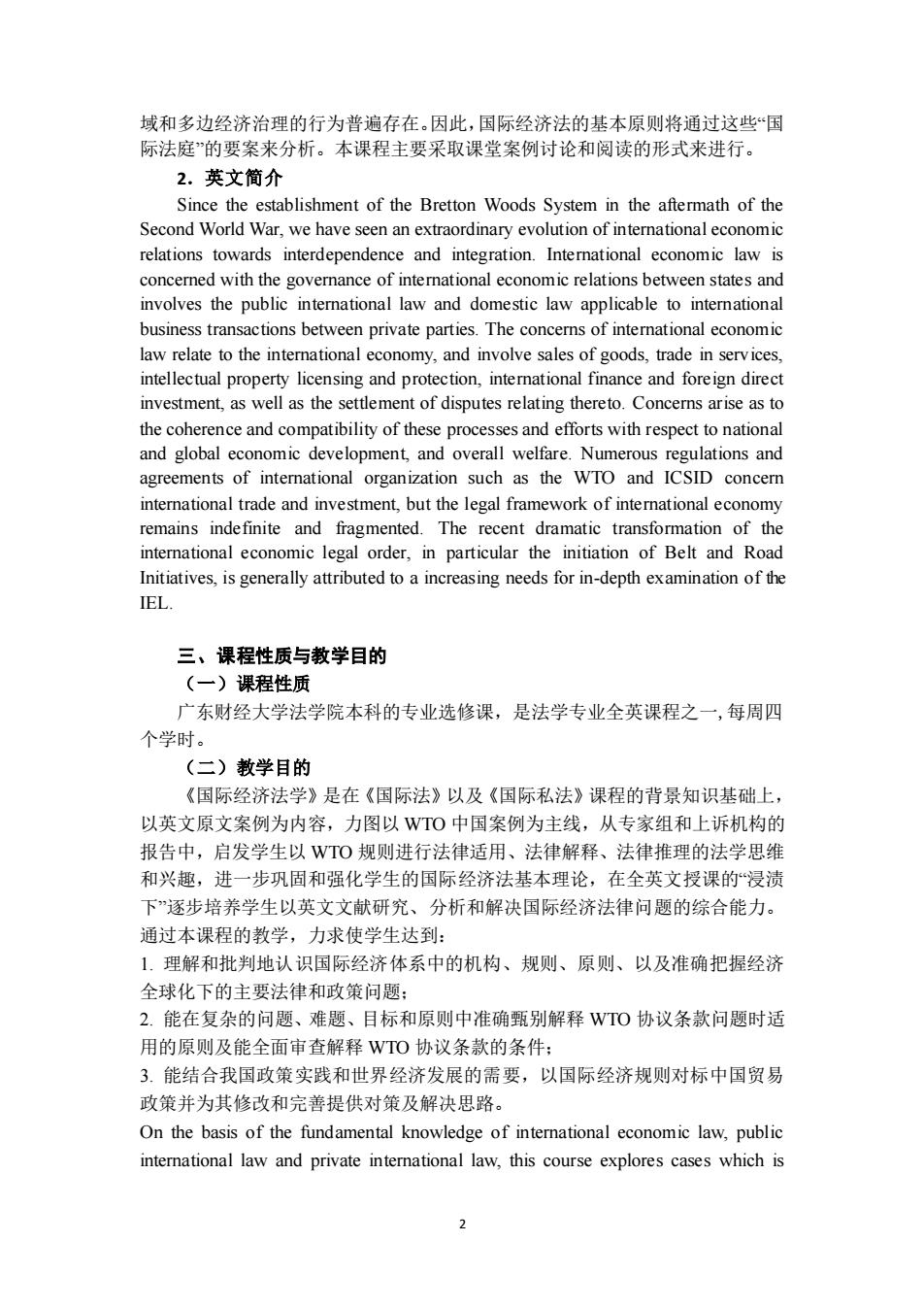
域和多边经济治理的行为普遍存在.因此,国际经济法的基本原则将通过这些“国 际法庭“的要案来分析。本课程主要采取课堂案例讨论和阅读的形式来进行。 2.英文简介 Since the establishment of the Bretton Woods System in the aftermath of the relations towards interdependence and integration.International economic law is concerned with the governance of international economic relations between states and involves the public intemational law and domestic law applicable to intemational business transactions between private parties.The concems of intemational economi law relate to the international economy,and involve sales of goods,trade in services, intellectual property licensing and protection,interational finance and foreign direct investment,as well as the settlement of disputes relating thereto.Concems arise as to the coherence and compatibility of these processes an efforts with respect to national and global economic development and overall welfare.Numerous regulations and agreements of international organization such as the WTO and ICSID concern interational trade and investment,but the legal framework of intemational economy remains indefinite and The recent dramati of the international economic legal order,in particular the initiation of Belt and Road Initiatives,is generally attributed to a increasing needs for in-depth examination of the IEL 三、课程性质与教学目的 (一)课程性质 广东财经大学法学院本科的专业选修课,是法学专业全英课程之一,每周四 个学时 (二)教学目的 《国际经济法学》是在《国际法》以及《国际私法》课程的背景知识基础上, 以英文原文案例为内容,力图以WTO中国案例为主线,从专家组和上诉机构的 报告中,启发学生以WTO规则进行法律适用、法律解释、法律推理的法学思维 和兴趣,进一步巩固和强化学生的国际经济法基本理论,在全英文授课的“浸渍 下”逐步培养学生以英文文献研究、分析和解决国际经济法律问题的综合能力。 通过本课程的教学,力求使学生达到: 1.理解和批判地认识国际经济体系中的机构、规则、原则、以及准确把握经济 全球化下的主要法律和改箭问颗: 2.能在复杂的问题、难题、目标和原则中准确甄别解释wTO协议条款问题时适 用的原则及能全面审查解释V"TO协议条款的条件: 3.能结合我因政策实践和世界经济发展的需要,以国际经济规则对标中国贸易 政策并为其修改和完善提供对策及解决思路。 On the basis of the fundamental knowledge of interational economic law,public international law and private international law,this course explores cases which is
2 域和多边经济治理的行为普遍存在。因此,国际经济法的基本原则将通过这些“国 际法庭”的要案来分析。本课程主要采取课堂案例讨论和阅读的形式来进行。 2.英文简介 Since the establishment of the Bretton Woods System in the aftermath of the Second World War, we have seen an extraordinary evolution of international economic relations towards interdependence and integration. International economic law is concerned with the governance of international economic relations between states and involves the public international law and domestic law applicable to international business transactions between private parties. The concerns of international economic law relate to the international economy, and involve sales of goods, trade in services, intellectual property licensing and protection, international finance and foreign direct investment, as well as the settlement of disputes relating thereto. Concerns arise as to the coherence and compatibility of these processes and efforts with respect to national and global economic development, and overall welfare. Numerous regulations and agreements of international organization such as the WTO and ICSID concern international trade and investment, but the legal framework of international economy remains indefinite and fragmented. The recent dramatic transformation of the international economic legal order, in particular the initiation of Belt and Road Initiatives, is generally attributed to a increasing needs for in-depth examination of the IEL. 三、课程性质与教学目的 (一)课程性质 广东财经大学法学院本科的专业选修课,是法学专业全英课程之一,每周四 个学时。 (二)教学目的 《国际经济法学》是在《国际法》以及《国际私法》课程的背景知识基础上, 以英文原文案例为内容,力图以 WTO 中国案例为主线,从专家组和上诉机构的 报告中,启发学生以 WTO 规则进行法律适用、法律解释、法律推理的法学思维 和兴趣,进一步巩固和强化学生的国际经济法基本理论,在全英文授课的“浸渍 下”逐步培养学生以英文文献研究、分析和解决国际经济法律问题的综合能力。 通过本课程的教学,力求使学生达到: 1. 理解和批判地认识国际经济体系中的机构、规则、原则、以及准确把握经济 全球化下的主要法律和政策问题; 2. 能在复杂的问题、难题、目标和原则中准确甄别解释 WTO 协议条款问题时适 用的原则及能全面审查解释 WTO 协议条款的条件; 3. 能结合我国政策实践和世界经济发展的需要,以国际经济规则对标中国贸易 政策并为其修改和完善提供对策及解决思路。 On the basis of the fundamental knowledge of international economic law, public international law and private international law, this course explores cases which is
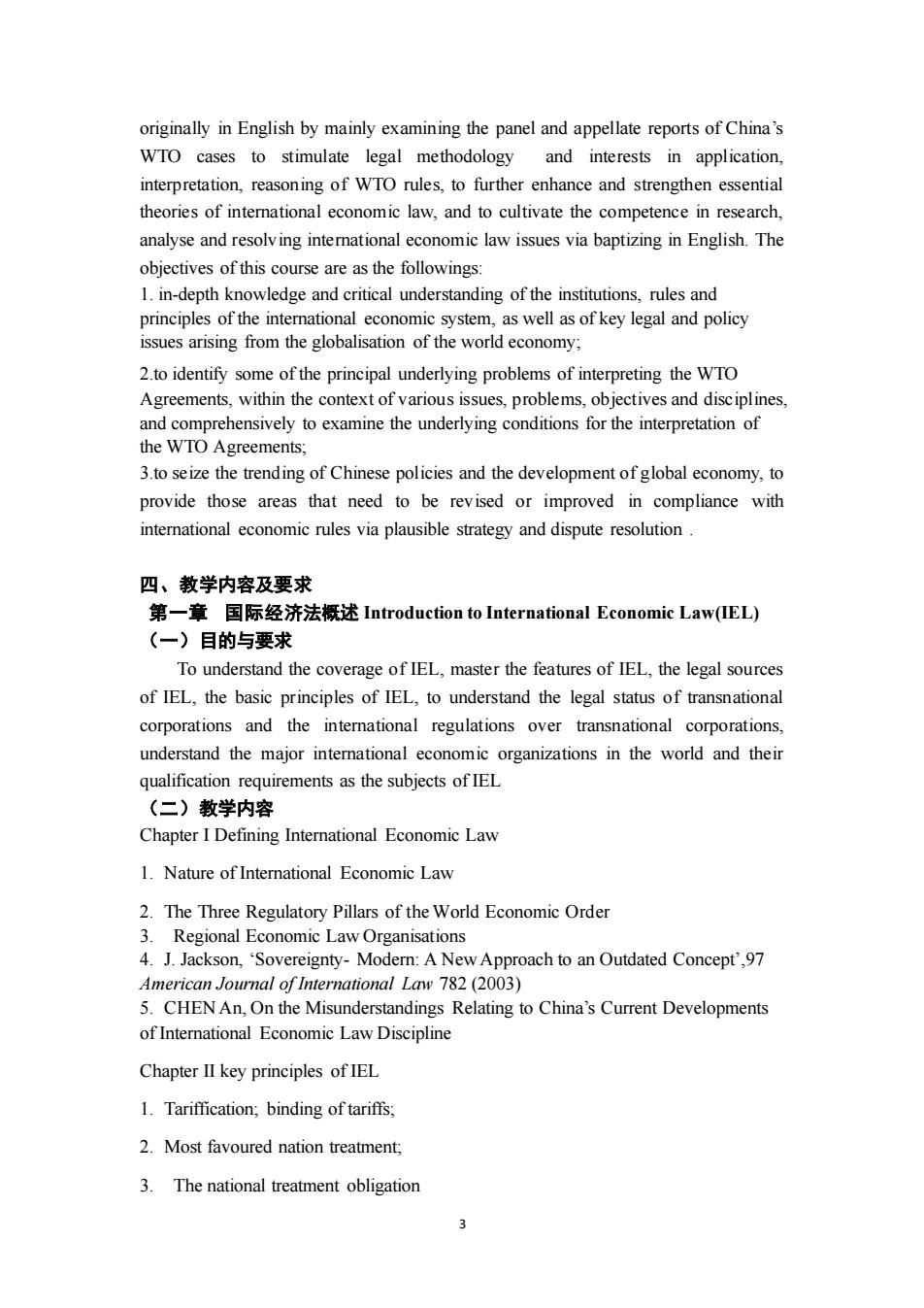
originally in English by mainly examining the panel and appellate reports of China's WTO cases to stimulate legal methodology and interests in application interpretation,reasoning of WTO rules,to further enhance and strengthen essential theories of international economic law,and to cultivate the competence in research, analyse and resolving intemational economic law issues via baptizing in English.The obiectives of this course are as the followings: 1.in-depth knowledge and critical understanding of the institutions,rules and principles of the international economic system,as well as of key legal and policy issues arising from the globalisation of the world economy: 2.to identify some of the principal underlying problems of interpreting the WTO Agreements,within the context of various issues,problems,objectives and disciplines, and comprehensively to examine the underlying conditions for the interpretation of the WTo Agreements: 3.to seize the trending of Chinese policies and the development of global economy,to provide those areas that need to be revised or improved in compliance with intemational economic rules via plausible strategy and dispute resolution 四、教学内容及要求 第一章国际经济法概述Introduction to International Economic Law(EL) (一)目的与要求 To understand the coverage of IEL,master the features of IEL,the legal sources of IEL,the basic principles of IEL,to understand the legal status of transnational corporations and the intemational regulations over transnational corporations. understand the major international economic organizations in the world and their qualification requirements as the subjects of IEL (二)教学内容 Chapter I Defining Interational Economic Law 1.Nature of Interational Economic Law 2.The Three Regulatory Pillars of the World Economic Order Law On eations eignty- m:A Ne Approach to an Outdated Concept,97 American Journal of International Law 782 (2003) 5.CHEN An,On the Misunderstandings Relating to China's Current Developments of International Economic Law Discipline Chapter II key principles of IEL 1.Tariffication,binding of tariffs, 2.Most favoured nation treatment 3.The national treatment obligation
3 originally in English by mainly examining the panel and appellate reports of China’s WTO cases to stimulate legal methodology and interests in application, interpretation, reasoning of WTO rules, to further enhance and strengthen essential theories of international economic law, and to cultivate the competence in research, analyse and resolving international economic law issues via baptizing in English. The objectives of this course are as the followings: 1. in-depth knowledge and critical understanding of the institutions, rules and principles of the international economic system, as well as of key legal and policy issues arising from the globalisation of the world economy; 2.to identify some of the principal underlying problems of interpreting the WTO Agreements, within the context of various issues, problems, objectives and disciplines, and comprehensively to examine the underlying conditions for the interpretation of the WTO Agreements; 3.to seize the trending of Chinese policies and the development of global economy, to provide those areas that need to be revised or improved in compliance with international economic rules via plausible strategy and dispute resolution . 四、教学内容及要求 第一章 国际经济法概述 Introduction to International Economic Law(IEL) (一)目的与要求 To understand the coverage of IEL, master the features of IEL, the legal sources of IEL, the basic principles of IEL, to understand the legal status of transnational corporations and the international regulations over transnational corporations, understand the major international economic organizations in the world and their qualification requirements as the subjects of IEL (二)教学内容 Chapter I Defining International Economic Law 1. Nature of International Economic Law 2. The Three Regulatory Pillars of the World Economic Order 3. Regional Economic Law Organisations 4. J. Jackson, ‘Sovereignty- Modern: A New Approach to an Outdated Concept’,97 American Journal of International Law 782 (2003) 5. CHEN An, On the Misunderstandings Relating to China’s Current Developments of International Economic Law Discipline Chapter II key principles of IEL 1. Tariffication; binding of tariffs; 2. Most favoured nation treatment; 3. The national treatment obligation

4.The Implications for Developing Countries of"the Great 1994 Sovereignty Debate" and the EC-US Eco Sovereignty Disputes (三)思考与实践 1.:What are the challenges to the fundamental logic and axioms of international law 2.Traditional Westphalian sovereignty concepts:outmoded and discredited? 3.Is"China Threa Doctrine"His y or Reality,Fabrication or Truth? 4.What are the key institutions traditionally regarded as central to the study of International Economic Law and which are left out? 5.Who are the key actors traditionally regarded as central to the study of Interational Economic law and who is left out? 6.Wha traditionally regarded as the sources of intemational economic law and what are left out? 7.Why are we so attracted to international economic institutions.and why are they so unsuccessful in delivering justice and development? 8.What Should Be China's Strategic Position in the Establishment onomic Order? (四)教学方法与手段 教学方法:课堂讲授、分组讨论、案例分析、课内外作业、调查研究和社会 实践、慕课、微课、翻转课堂等。 教学手段:投影、幻打、计算机、网络铺助教学等名媒体手段 第二章国际货物买卖合同法Introduction to International Sale of Goods Law (一)目的与要求 To grasp the connotation of contracts for the international sale of goods.to understand the characteristics of the legal system on the intemational sale of goods through the CISG and INCOTERMS (二)教学内容 Introduction to International Sale of Goods Law 1.Applicable law of International Sale of Goods Contract Applicability of CISG Formation of the Contrac Elements of Contract under CISG 5 Ascertaining the Terms of the Contract 6 Contract Interpretation 7.Seller's Obligations under CISG 8. Buyer'sblations under C Additional Time for Performance under CISG 10.Price Reduction under CISG 11.Suspension of Performance under CISG 12.Avoidance of Contract 13.Damage
4 4.The Implications for Developing Countries of “the Great 1994 Sovereignty Debate” and the EC–US Economic Sovereignty Disputes (三)思考与实践 1.:What are the challenges to the fundamental logic and axioms of international law 2.Traditional Westphalian sovereignty concepts: outmoded and discredited? 3.Is “China Threat Doctrine” History or Reality, Fabrication or Truth? 4.What are the key institutions traditionally regarded as central to the study of International Economic Law and which are left out? 5.Who are the key actors traditionally regarded as central to the study of International Economic Law and who is left out? 6. What are traditionally regarded as the sources of international economic law and what are left out? 7. Why are we so attracted to international economic institutions, and why are they so unsuccessful in delivering justice and development? 8. What Should Be China’s Strategic Position in the Establishment of New International Economic Order? (四)教学方法与手段 教学方法:课堂讲授、分组讨论、案例分析、课内外作业、调查研究和社会 实践、慕课、微课、翻转课堂等。 教学手段:投影、幻灯、计算机、网络辅助教学等多媒体手段。 第二章 国际货物买卖合同法 Introduction to International Sale of Goods Law (一)目的与要求 To grasp the connotation of contracts for the international sale of goods,,to understand the characteristics of the legal system on the international sale of goods through the CISG and INCOTERMS (二)教学内容 Introduction to International Sale of Goods Law 1. Applicable law of International Sale of Goods Contract 2. Applicability of CISG 3. Formation of the Contract 4. Elements of Contract under CISG 5. Ascertaining the Terms of the Contract 6. Contract Interpretation 7. Seller’s Obligations under CISG 8. Buyer’s Obligations under CISG 9. Additional Time for Performance under CISG 10. Price Reduction under CISG 11. Suspension of Performance under CISG 12. Avoidance of Contract 13. Damage
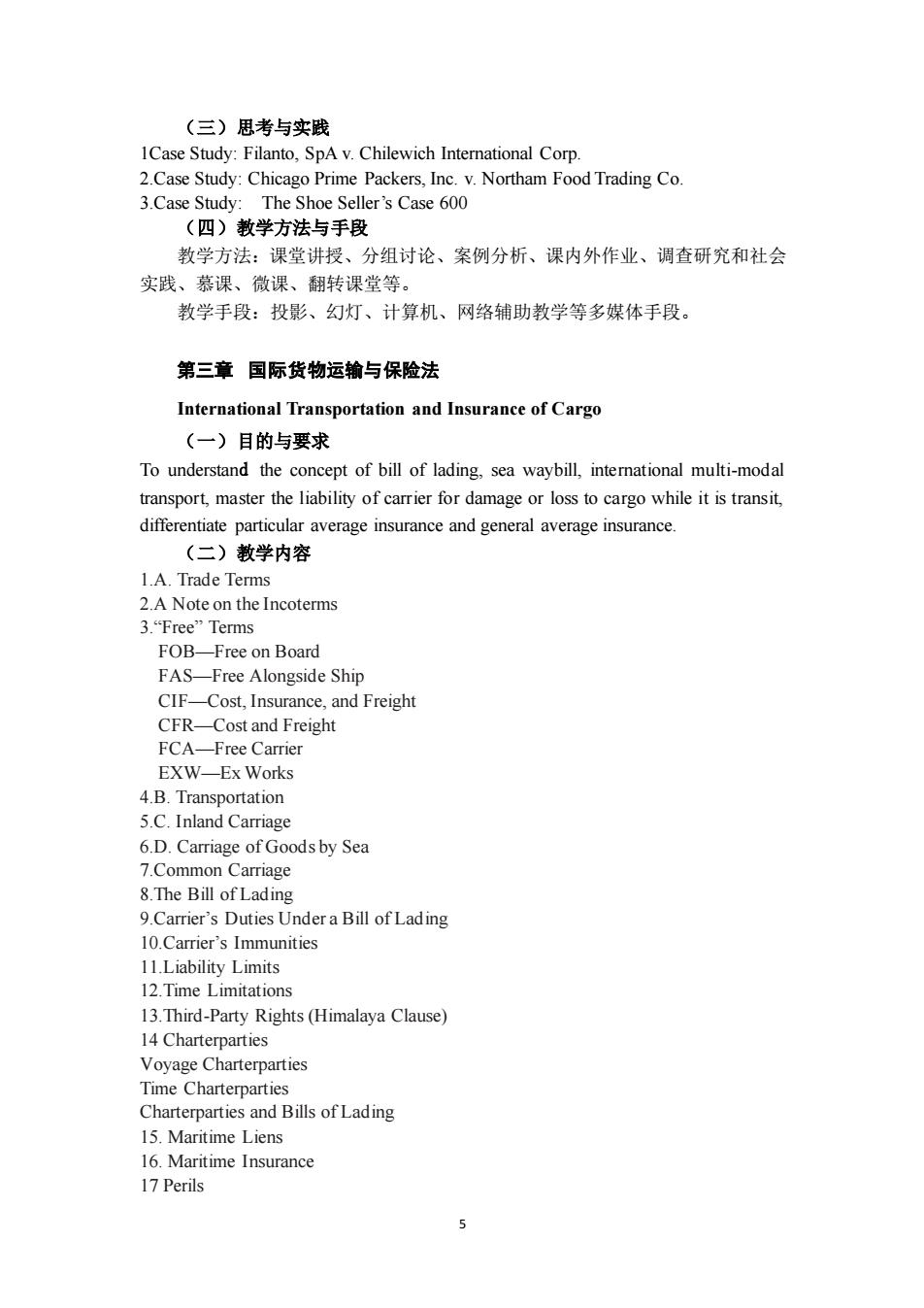
(三)思考与实践 ICase Study:Filanto,SpA v.Chilewich International Corp. 2.Case Study:Chicago Prime Packers,Inc.v.Northam Food Trading Co. 3 Case Study The Shoe Seller's Case 600 (四)教学方法与手段 教学方法:课堂讲授、分组讨论、案例分析、课内外作业、调查研究和社会 实践、慕课、微课、翻转课堂等。 教学手段:投影、幻灯、计算机、网络辅助教学等多媒体手段。 第三章国际货物运输与保险法 International Transportation and Insurance of Cargo (一)目的与要求 To understand the concept of bill of lading.sea waybill intemational multi-modal transport,master the liability of carrier for damage or loss to cargo while it is transit, differentiate particular average insurance and general average insurance. (二)教学内容 LA Trade Terms 2 A Note on the Incoterms 3.pree”Tem FOB-Free on Board FAS-Free Alongside Ship CIF-Cost.Insurance.and Freigh CFR-Cost and Freight 4.B.Transportation 5.C.Inland Carriage 6.D.Carriage of Goodsby Sea 7.Comn .The Bill of Lading 9.Carrier's Duties Under a Bill of Lading 10 Carrier's Immunities 11.Liability Limits 12 Time limitations 13.Third-Party Rights(Himalaya Clause) 14 Charterparties Voyage Charterparties Time charternarties Charterparties and Bills of Lading 15.Maritime e Liens 16.Maritime Insurance 17 Perils
5 (三)思考与实践 1Case Study: Filanto, SpA v. Chilewich International Corp. 2.Case Study: Chicago Prime Packers, Inc. v. Northam Food Trading Co. 3.Case Study: The Shoe Seller’s Case 600 (四)教学方法与手段 教学方法:课堂讲授、分组讨论、案例分析、课内外作业、调查研究和社会 实践、慕课、微课、翻转课堂等。 教学手段:投影、幻灯、计算机、网络辅助教学等多媒体手段。 第三章 国际货物运输与保险法 International Transportation and Insurance of Cargo (一)目的与要求 To understand the concept of bill of lading, sea waybill, international multi-modal transport, master the liability of carrier for damage or loss to cargo while it is transit, differentiate particular average insurance and general average insurance. (二)教学内容 1.A. Trade Terms 2.A Note on the Incoterms 3.“Free” Terms FOB—Free on Board FAS—Free Alongside Ship CIF—Cost, Insurance, and Freight CFR—Cost and Freight FCA—Free Carrier EXW—Ex Works 4.B. Transportation 5.C. Inland Carriage 6.D. Carriage of Goods by Sea 7.Common Carriage 8.The Bill of Lading 9.Carrier’s Duties Under a Bill of Lading 10.Carrier’s Immunities 11.Liability Limits 12.Time Limitations 13.Third-Party Rights (Himalaya Clause) 14 Charterparties Voyage Charterparties Time Charterparties Charterparties and Bills of Lading 15. Maritime Liens 16. Maritime Insurance 17 Perils

18 average clauses 19 Ca of Goods by Air (三)思考与实践 I Case Study:Great China Metal Industries Co.Ltd v.Malaysian Intemnational Shipping Corp 2C ase Study:The Chinese Seamen's Foreign Technical Services Co.v.Soto Grande Shipping Corp.Sa 3.Case Study:St.Paul Guardian Insurance Company v.Neuromed Medical Systems Support,GmbH 4 Case Study:Phillips puerto rico Core Inc y Tradax Petroleum ltd 5.Case Study:M.Golodetz&Co.,Inc.v.Czamikow-Rio daCO..Inc (四)教学方法与手段 教学方法:课堂讲授、分组讨论、案例分析、课内外作业、调查研究和社会 实践、慕课、微课、翻转课堂等。 教学手段:投影、幻灯、计算机、网络辅助教学等多媒体手段。 第四章知识产权的国际保护与技术贸易管理法 (一)目的与要求 To know the concept,classification of intellectual property rights,understand the concept,features and content of license agreement of intellectual property,to master the goverment regulations in technology transfer and main sources of intemational law on transfer of technology. (二)教学内容 The Creation of Intellectual Property Rights IIntellectual Property Organizations World Intellectual Property Organization 4.Council for Trade-Related Aspects of Intellectual Property Rights 5.The International Transfer of Intellectual Property (三)思考与实践 Case study:Amar nath sehgal y.Union of India 499 Patents 504 2.Case Study:Monsanto Co.v.Coramandal Indag Products,(P)Ltd.507 3.READING9-1 Starbucks and Ethiopia Dispute Coffee Trademark Issues 513 4. Case Study:L'Oreal v.eBay READING9-2 Compulsory Licensing of Patents on Aids and other Drugs:WTO Rules and Actions by Certain Nations 6.How to understand the difference in the attitudes towards the regulation of restrictive business practices between developing countries and developed countries? 6
6 18.Average Clauses 19. Carriage of Goods by Air (三)思考与实践 1.Case Study: Great China Metal Industries Co. Ltd. v. Malaysian International Shipping Corp 2Case Study: The Chinese Seamen’s Foreign Technical Services Co. v. Soto Grande Shipping Corp., Sa 3.Case Study: St. Paul Guardian Insurance Company v. Neuromed Medical Systems & Support, GmbH 4.Case Study: Phillips Puerto Rico Core, Inc. v. Tradax Petroleum, Ltd. 5.Case Study: M. Golodetz & Co., Inc. v. Czarnikow-Rionda CO., Inc. 6.Case Study: Assicurazioni Generali (Underwriters) v. Black & Veatch (四)教学方法与手段 教学方法:课堂讲授、分组讨论、案例分析、课内外作业、调查研究和社会 实践、慕课、微课、翻转课堂等。 教学手段:投影、幻灯、计算机、网络辅助教学等多媒体手段。 第四章 知识产权的国际保护与技术贸易管理法 International Protection of Intellectual Property (一)目的与要求 To know the concept, classification of intellectual property rights,understand the concept, features and content of license agreement of intellectual property, to master the government regulations in technology transfer and main sources of international law on transfer of technology. (二)教学内容 1. The Creation of Intellectual Property Rights 2. International Intellectual Property Organizations 3. World Intellectual Property Organization 4. Council for Trade-Related Aspects of Intellectual Property Rights 5. The International Transfer of Intellectual Property (三)思考与实践 1. Case Study: Amar Nath Sehgal v. Union of India 499 Patents 504 2. Case Study: Monsanto Co. v. Coramandal Indag Products, (P) Ltd. 507 3. READING 9-1 Starbucks and Ethiopia Dispute Coffee Trademark Issues 513 4. Case Study: L’Oréal v. eBay 5. READING 9-2 Compulsory Licensing of Patents on Aids and other Drugs: WTO Rules and Actions by Certain Nations 6. How to understand the difference in the attitudes towards the regulation of restrictive business practices between developing countries and developed countries?
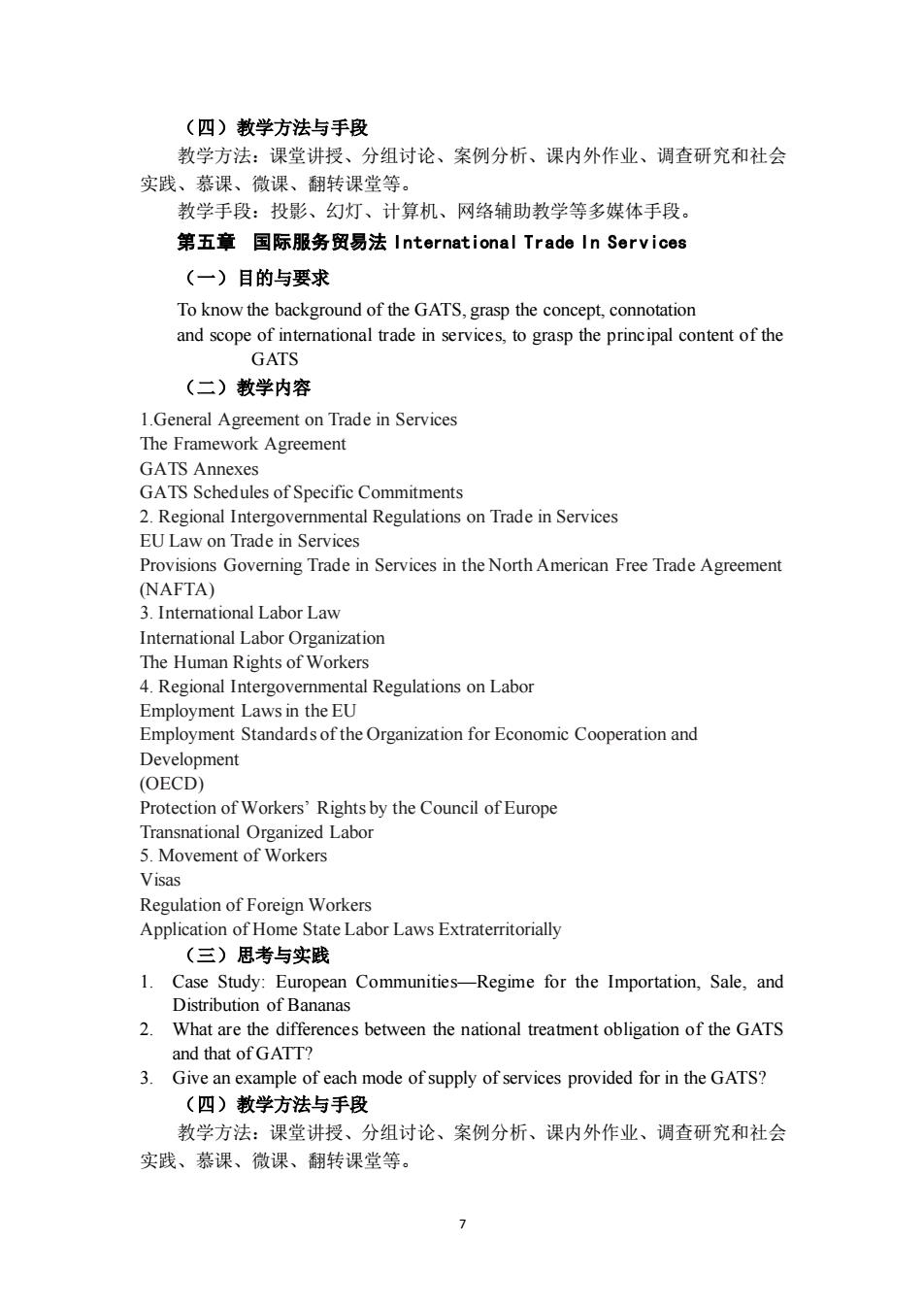
(四)教学方法与手段 教学方法:课堂讲授、分组讨论、案例分析、课内外作业、调查研究和社会 实践、慕课、微课、翻转课堂等 教学手段:投影、幻灯、计算机、网络辅助教学等多媒体手段。 第五章国际服务贸易法International Trade In Services (一)目的与要求 To know the background of the GATS.grasp the concept,connotation and scope of international trade in services,to grasp the principal content of the GATs (二)教学内容 1.General Agreement on Trade in Services The Framework Agreement GATS Annexes GATS Sehedules of Specific Commitments 2.Regional Intergovemmental Regulations on Trade in Services EU Law on Trade in Services Provisions Governing Trade in Services in the North American Free Trade Agreement (NAFTA) 3 International labor law 4.Regional Intergovernmental Regulations on Labor Employment Laws in the EU Employment Standards of the Organization for Economic Cooperation and Protection of Workers'Rights by the Council of Europe Transnational Organized Labor 5.Movement of Workers Visas Regulation of Foreign Workers Application of Home State Labor Laws Extraterritorially (三)思考与实践 1.Case Study:E tion of BanaKegime for the Importation,Sale ananas 2.What are the differences between the national treatment obligation of the GATS and that of GaTT? 3.Give an example of each mode of supply of services provided for in the GATS? (四)教学方法与手段 教学方法:课堂讲授、分组讨论、案例分析、课内外作业、调查研究和社会 实践、慕课、微课、翻转课堂等
7 (四)教学方法与手段 教学方法:课堂讲授、分组讨论、案例分析、课内外作业、调查研究和社会 实践、慕课、微课、翻转课堂等。 教学手段:投影、幻灯、计算机、网络辅助教学等多媒体手段。 第五章 国际服务贸易法 International Trade In Services (一)目的与要求 To know the background of the GATS, grasp the concept, connotation and scope of international trade in services, to grasp the principal content of the GATS (二)教学内容 1.General Agreement on Trade in Services The Framework Agreement GATS Annexes GATS Schedules of Specific Commitments 2. Regional Intergovernmental Regulations on Trade in Services EU Law on Trade in Services Provisions Governing Trade in Services in the North American Free Trade Agreement (NAFTA) 3. International Labor Law International Labor Organization The Human Rights of Workers 4. Regional Intergovernmental Regulations on Labor Employment Laws in the EU Employment Standards of the Organization for Economic Cooperation and Development (OECD) Protection of Workers’ Rights by the Council of Europe Transnational Organized Labor 5. Movement of Workers Visas Regulation of Foreign Workers Application of Home State Labor Laws Extraterritorially (三)思考与实践 1. Case Study: European Communities—Regime for the Importation, Sale, and Distribution of Bananas 2. What are the differences between the national treatment obligation of the GATS and that of GATT? 3. Give an example of each mode of supply of services provided for in the GATS? (四)教学方法与手段 教学方法:课堂讲授、分组讨论、案例分析、课内外作业、调查研究和社会 实践、慕课、微课、翻转课堂等

教学手段:投影、幻灯、计算机、网络辅助教学等多媒体手段 第六章国际货物贸易管理法International Trade and The World Trade Organization (一)目的与要求 To know the concept,characteristics of the international trade law and master China's Legal system on imports and exports administration,to understand the basic principle of WTO,to master the multilateral rules of WTO on tariffs, anti-du ures subsidies and co ountervailing measures (二)教学内容 1.The WTO Agreement 2 Membership of the WTO Structure f the WTO A. Decision Making within the WTO 5. The 1994 General Agreement on Tariffs and Trade 6.Major principles of GATT1994 7 Customs Valuation Preshipment Inspection 9 Technical Barriers to Trade 10.Sanitary and Phytosanitary Measures 11.Import-Licensing Procedures 12.Anti-dumping 13.Subsidies and Countervailing Measures 14.Safeguards 15.Agriculture 16.Textiles and Clothing 17.Rules of Origin 18.Trade-Related Investment Measures (三)思考与实践 1.Case Study:Japan-Taxes on Alcoholic Beverages 2.Case Study:United States-Import Prohibition of Certain Shrimp and Shrimp dy:China Raw Materials(DS394/395/398) Case Study:Australia-Measures Affecting Importation of Salmon 5.Case Study:Nippon Steel Corporation v.United States 6.Case Study:United States-European Communities-Measures Affecting Trade in Large Civil Aircraft 7.Explain the basic principle of GATT1994. (四)教学方法与手段 教学方法:课堂讲授、分组讨论、案例分析、课内外作业、调查研究和社会 实践、慕课、微课、翻转课堂等。 教学手段:投影、幻灯、计算机、网络辅助教学等多媒体手段
8 教学手段:投影、幻灯、计算机、网络辅助教学等多媒体手段。 第六章 国际货物贸易管理法 International Trade and The World Trade Organization (一)目的与要求 To know the concept, characteristics of the international trade law and master China’s Legal system on imports and exports administration, to understand the basic principle of WTO, to master the multilateral rules of WTO on tariffs, anti-dumping measures, subsidies and countervailing measures (二)教学内容 1. The WTO Agreement 2. Membership of the WTO 3. Structure of the WTO 4. Decision Making within the WTO 5. The 1994 General Agreement on Tariffs and Trade 6. Major principles of GATT 1994 7. Customs Valuation 8. Preshipment Inspection 9. Technical Barriers to Trade 10. Sanitary and Phytosanitary Measures 11. Import-Licensing Procedures 12. Anti-dumping 13. Subsidies and Countervailing Measures 14. Safeguards 15. Agriculture 16. Textiles and Clothing 17. Rules of Origin 18. Trade-Related Investment Measures (三)思考与实践 1. Case Study: Japan—Taxes on Alcoholic Beverages 2. Case Study: United States—Import Prohibition of Certain Shrimp and Shrimp Products 3. Case Study: China Raw Materials(DS394/395/398) 4. Case Study: Australia—Measures Affecting Importation of Salmon 5. Case Study: Nippon Steel Corporation v. United States 6. Case Study: United States—European Communities—Measures Affecting Trade in Large Civil Aircraft 7. Explain the basic principle of GATT 1994. (四)教学方法与手段 教学方法:课堂讲授、分组讨论、案例分析、课内外作业、调查研究和社会 实践、慕课、微课、翻转课堂等。 教学手段:投影、幻灯、计算机、网络辅助教学等多媒体手段
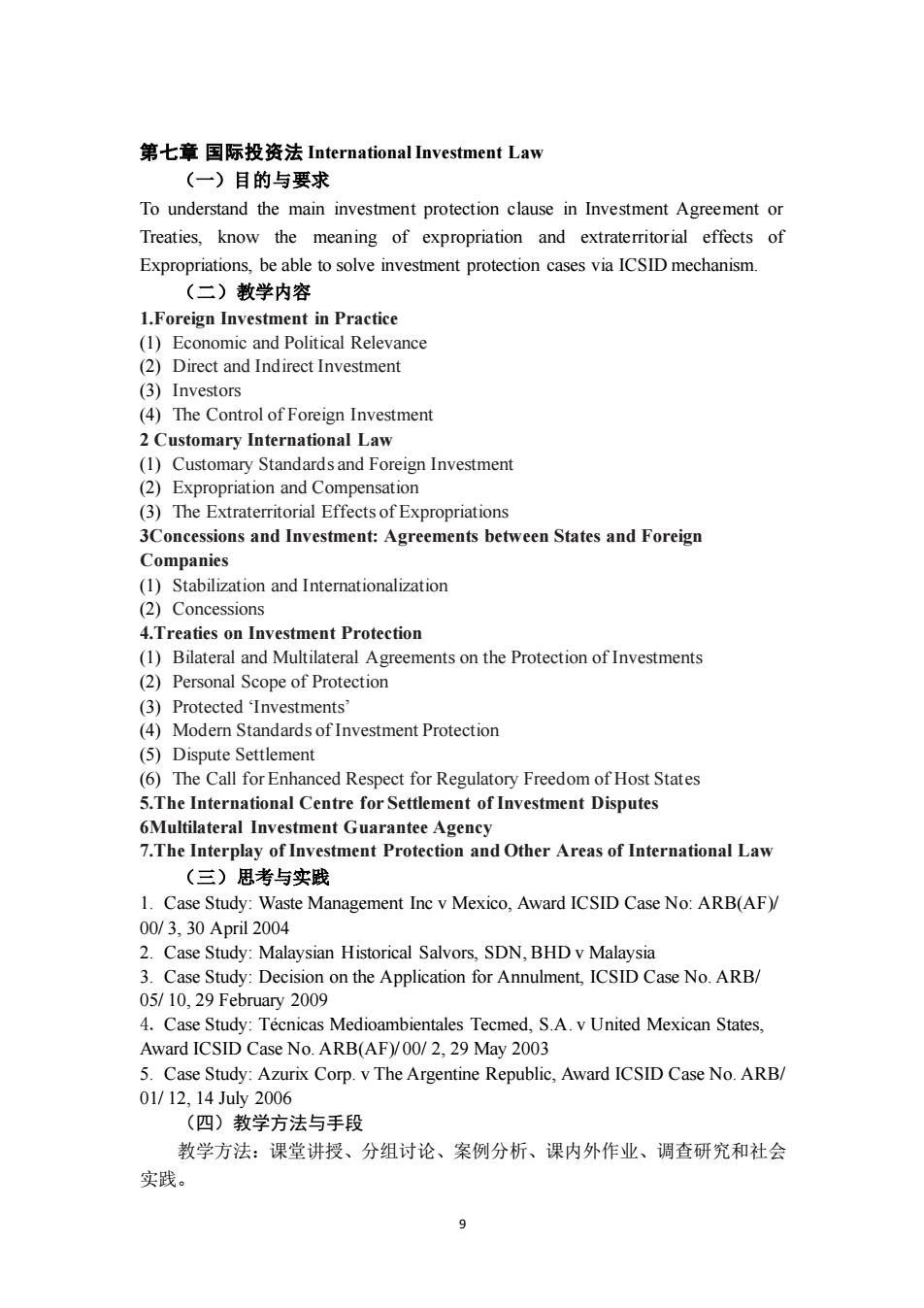
第七章国际投资法International Investment Law (一)目的与要求 To understand the main investment protection clause in Investment Agreement or Treaties,know the meaning of expropriation and extraterritorial effects of Expropriations,be able to solve investment protection cases via ICSID mechanism. (二)教学内容 1.Foreign Investment in Practice (1)Economic and Political Relevance (2)Direct and Indirect Investment (Investors (4)The Control of Foreign Investment 2 Customary International Law (1)Customary Standards and Foreign Investment (2)Expropriation and Compensation (3)The Extraterritorial Effects of Expropriations 3Concessions and Investment:Agreements between States and Foreign Companies (1)Stabilization and Intemationalization (2)Concessions 4.Treaties on Investment Protection (1)Bilateral and Multilateral Agreements on the Protection of Investments (2)Personal Scope of Protection (3)Protected'Investments (4)Modern Standards of Investment Protection (⑤)Dispute Settlement (6)The Call for Enhanced Respect for Regulatory Freedom of Host States 5.The International Centre for r Settlen ent of Investment Disputes 6Multilateral Investment Guarantee Agency 7.The Interplay of Investment Protection and Other Areas of International Law (三)思考与实践 1.Case Study:Waste Management Inc v Mexico,Award ICSID Case No:ARB(AF) 00/3,30 April2004 2.Case Study:Malavsian Historical Salvors.SDN.BHD v Malavsia 3.Case Study:Decision on the Application for Annulment,ICSID Case No.ARB/ 05/10.29 February2009 4.Case Study:Tecnicas Medioambientales Tecmed,S.A.v United Mexican States. Award ICSID Case No.ARB(AF)/00/2,29 May 2003 5.Case Study:Azurix Corp.vThe Argentine Republic,Award ICSID Case No.ARB 01/12,14Juy2006 (四)教学方法与手段 教学方法:课堂讲授、分组讨论、案例分析、课内外作业、调查研究和社会 实践。 9
9 第七章 国际投资法 InternationalInvestment Law (一)目的与要求 To understand the main investment protection clause in Investment Agreement or Treaties, know the meaning of expropriation and extraterritorial effects of Expropriations, be able to solve investment protection cases via ICSID mechanism. (二)教学内容 1.Foreign Investment in Practice (1) Economic and Political Relevance (2) Direct and Indirect Investment (3) Investors (4) The Control of Foreign Investment 2 Customary International Law (1) Customary Standards and Foreign Investment (2) Expropriation and Compensation (3) The Extraterritorial Effects of Expropriations 3Concessions and Investment: Agreements between States and Foreign Companies (1) Stabilization and Internationalization (2) Concessions 4.Treaties on Investment Protection (1) Bilateral and Multilateral Agreements on the Protection of Investments (2) Personal Scope of Protection (3) Protected ‘Investments’ (4) Modern Standards of Investment Protection (5) Dispute Settlement (6) The Call for Enhanced Respect for Regulatory Freedom of Host States 5.The International Centre for Settlement of Investment Disputes 6Multilateral Investment Guarantee Agency 7.The Interplay of Investment Protection and Other Areas of International Law (三)思考与实践 1. Case Study: Waste Management Inc v Mexico, Award ICSID Case No: ARB(AF)/ 00/ 3, 30 April 2004 2. Case Study: Malaysian Historical Salvors, SDN, BHD v Malaysia 3. Case Study: Decision on the Application for Annulment, ICSID Case No. ARB/ 05/ 10, 29 February 2009 4. Case Study: Técnicas Medioambientales Tecmed, S.A. v United Mexican States, Award ICSID Case No. ARB(AF)/ 00/ 2, 29 May 2003 5. Case Study: Azurix Corp. v The Argentine Republic, Award ICSID Case No. ARB/ 01/ 12, 14 July 2006 (四)教学方法与手段 教学方法:课堂讲授、分组讨论、案例分析、课内外作业、调查研究和社会 实践
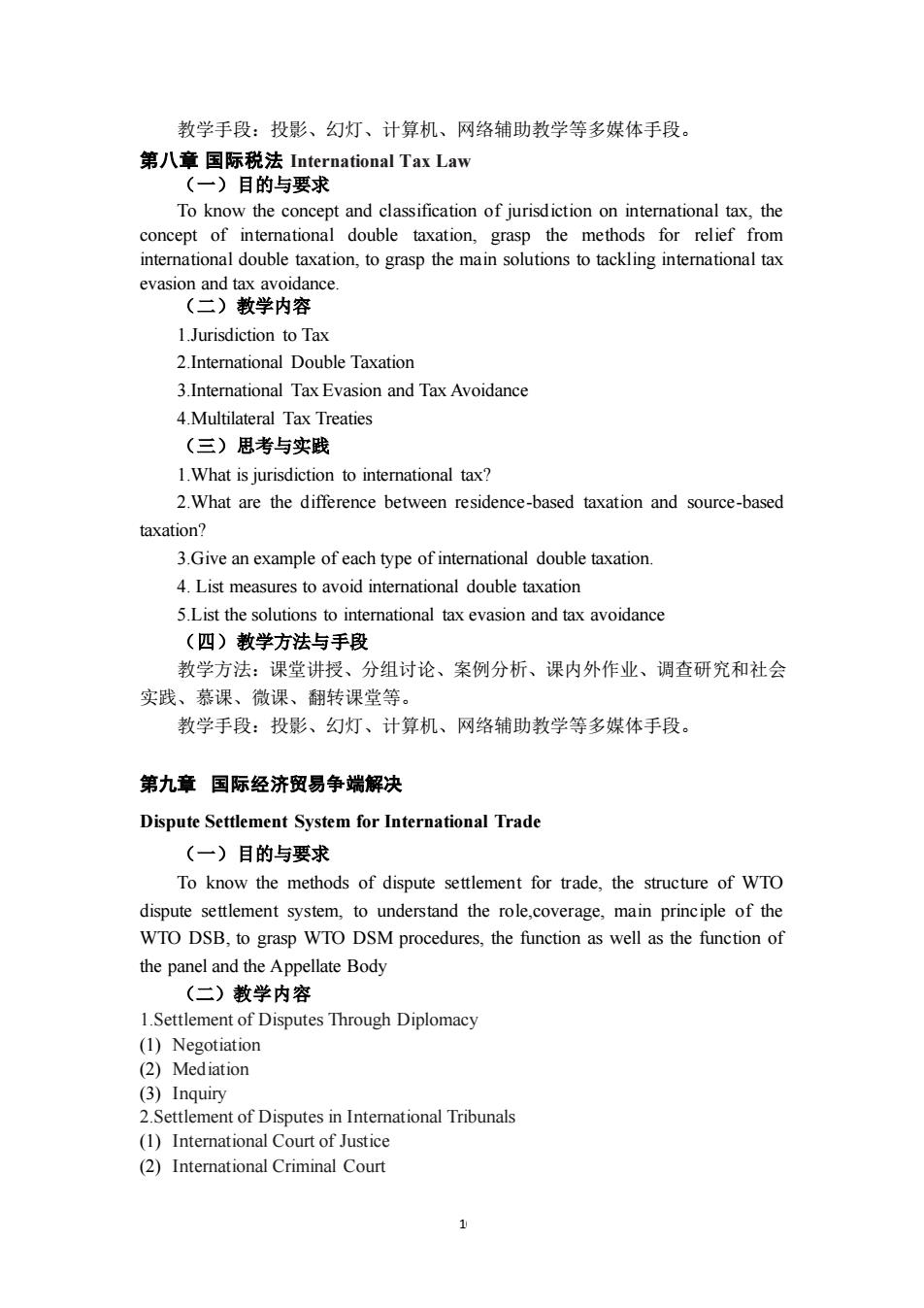
教学手段:投影、幻灯、计算机、网络辅助教学等多媒体手段。 ( To know the concept and classification of jurisdiction on international tax,the concept of international double taxation,grasp the methods for relief from interational double taxation,to grasp the main solutions to tackling international tax evasior ☐教学内容 1 lurisdiction to Tax 2.International Double Taxation 3.International Tax Evasion and Tax Avoidance 4.Multilateral Tax Treaties (三)思考与实践 1.What is jurisdiction to intemational tax? 2.What are the difference between residence-based taxation and source-based taxation? 3.Give an example of each type of international double taxation. 4.List measures to avoid intemational double taxation 5.List the solutions to international tax evasion and tax avoidance (四)教学方法与手段 教学方法:课堂讲授、分组讨论、案例分析、课内外作业、调查研究和社会 实践、慕课、微课、翻转课堂等。 教学手段:投影、幻灯、计算机、网络辅助教学等多媒体手段。 第九章国际经济贸易争端解决 Dispute Settlement System for International Trade (一)目的与要求 To know the methods of dispute settlement for trade,the structure of WTO dispute settlement system,to understand the role,coverage,main principle of the WTO DSB,to grasp WTO DSM procedures,the function as well as the function of the panel and the Appellate Body (二)教学内容 1.Settlement of Disputes Through Diplomacy (1)Negotiation (2)Mediation (1)Interational Court of Justice (2)Intemnational Criminal Court
10 教学手段:投影、幻灯、计算机、网络辅助教学等多媒体手段。 第八章 国际税法 International Tax Law (一)目的与要求 To know the concept and classification of jurisdiction on international tax, the concept of international double taxation, grasp the methods for relief from international double taxation, to grasp the main solutions to tackling international tax evasion and tax avoidance. (二)教学内容 1.Jurisdiction to Tax 2.International Double Taxation 3.International Tax Evasion and Tax Avoidance 4.Multilateral Tax Treaties (三)思考与实践 1.What is jurisdiction to international tax? 2.What are the difference between residence-based taxation and source-based taxation? 3.Give an example of each type of international double taxation. 4. List measures to avoid international double taxation 5.List the solutions to international tax evasion and tax avoidance (四)教学方法与手段 教学方法:课堂讲授、分组讨论、案例分析、课内外作业、调查研究和社会 实践、慕课、微课、翻转课堂等。 教学手段:投影、幻灯、计算机、网络辅助教学等多媒体手段。 第九章 国际经济贸易争端解决 Dispute Settlement System for International Trade (一)目的与要求 To know the methods of dispute settlement for trade, the structure of WTO dispute settlement system, to understand the role,coverage, main principle of the WTO DSB, to grasp WTO DSM procedures, the function as well as the function of the panel and the Appellate Body (二)教学内容 1.Settlement of Disputes Through Diplomacy (1) Negotiation (2) Mediation (3) Inquiry 2.Settlement of Disputes in International Tribunals (1) International Court of Justice (2) International Criminal Court